By the end of the 1920s, aeronautical technology had developed sufficiently for designers to begin thinking about solutions to certain inherent drawbacks in the basic concept of aircraft. One of these, undoubtedly the most fundamental, is the unavoidable need for a large stretch of land for takeoff and landing. After all, flight needs speed, and speed requires space.
The search began with the simplest idea, that of rotating wings, already imagined many centuries ago by Leonardo da Vinci, but putting it into practice became a long journey whose goal seemed to get further away with each step. And the other idea, somewhat crude but much more viable, consisted of reducing the stall speed of the aircraft to minimum values through aerodynamic devices. For less speed means less runway.
In Argentina, several aircraft designed to operate from small and unprepared fields have flown, but the truth is that only a couple of models truly deserved the STOL (Short Take Off and Landing) designation, and one of them was the Morane-Saulnier MS-502. This is its history.
The Designer
Gerhard Fieseler was born in Glesch, near Köln (Cologne), Germany, in 1896. At the outbreak of World War I, at 18 years of age, he volunteered for the nascent military aviation and in a very short time became a well-known pilot, both for his effectiveness (achieving 19 confirmed kills) and for being a technical innovator (he developed a machine gun that fired obliquely upward). He received the highest decorations and was promoted to officer, but at the end of the war, he left the military and took up the printing trade, inherited from his father.
In the early 1920s, with the limitations of the Treaty of Versailles still in force, gliding was developing strongly in Germany, with its main center in the mountainous Rhine region. Within a couple of years, Fieseler returned to flying activities, this time in sports, first with gliders and then with powered aircraft, and very soon became famous performing aerobatics. So much so that between 1926 and 1934, he won the German aerobatic championship five times, the European continental title twice, and in 1934, no less than the world title.
After winning his first German championship in 1926, he decided to leave his printing trade to dedicate himself professionally to aeronautics, and soon became known for his participation in the design of aerobatic aircraft built by Raab Katzenstein Flugzeugwerke of Kassel, a company in which he eventually became a partner. In 1930, he became independent by acquiring the Max Kegel Segelflugzeugbau glider factory, whose business name was changed on April 1st to Fieseler Flugzeugbau Kassel, a name well known in Argentina as dozens of their training gliders flew in our gliding clubs, and also worldwide for having built the “Austria,” the largest sailplane of that era, with cantilever wings spanning 30 meters.
By 1932, Fieseler was already famous for his aerobatic aircraft, so in 1933 he decided to prioritize aircraft design over gliders and changed the company name to Fieseler Flugzeugwerke, which on April 1st, 1933, became the corporation Gerhard Fieseler Werke GmbH. During World War II, he left the military and dedicated himself to the printing trade, inherited from his father.
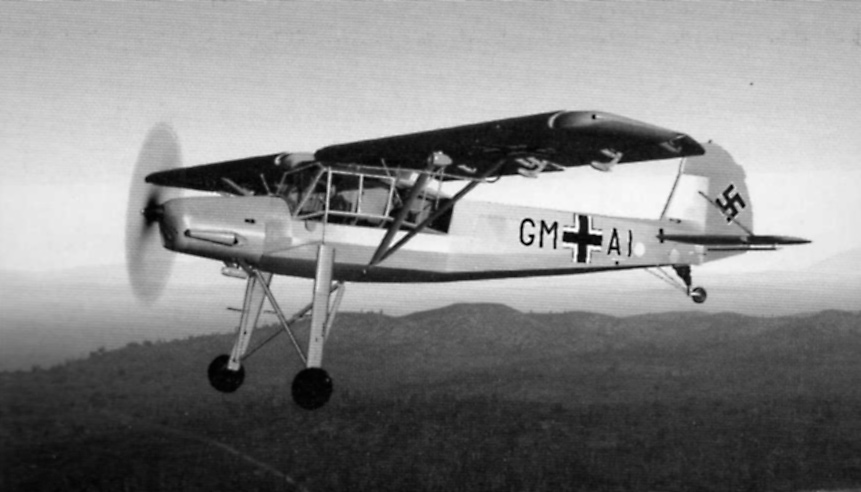
Technical Characteristics and Development
The aircraft had two characteristics that made it different: a landing gear with extremely long legs and wide track, designed to easily absorb terrain irregularities, and high-mounted wings of great span (more than 14 meters) equipped with large trailing edge flaps and significant leading-edge slats (similar to the English Handley Page), both spanning the entire wingspan. The engine was an inverted V8 air-cooled Argus As.10C of 240 hp that gave it a maximum speed of about 175 km/h, which wasn’t extraordinary, but at less than 50 km/h the aircraft continued flying perfectly, which was marvelous. Its stall speed was close to 45 km/h, which meant that with strong headwinds it could take off almost like a helicopter, and in normal operations, it could take off and land in just a few dozen meters.
The prototype (registration D-IKVN, c/n V1) first flew around April 1936, followed by five other examples built to evaluate the different variants and equipment of the model (D-IDVS, c/n V2, D-IGLN c/n V3, D-IPFM, c/n V4, and D-IYZO, c/n V5), and once approved, it went into production as the Fi.156A model, with the first aircraft being delivered for military use starting in March 1937.
Operational History
I won’t detail here the operational career of this aircraft. Suffice it to say that about 2,900 units were built and it flew on all war fronts where Germany was involved, where the Storch became indispensable for its reliability and unmatched performance.
Famous flights included Otto Skorzeny’s rescue of Benito Mussolini on September 12, 1943, from the hotel located in the Apennine Mountains where he was imprisoned, or that of our well-known Hanna Reitsch over the ruins of Berlin on April 26, 1945, to transport General Robert Ritter von Greim, to be appointed as the new commander-in-chief of the Luftwaffe.
What’s interesting for our history is that the Storch was also built in various factories occupied by German invasion troops, mainly in Czechoslovakia by Mraz as the K-65 Cap model, and in France by Morane-Saulnier. And after the war ended, Morane-Saulnier decided to continue manufacturing it as the MS-500 Criquet, as it was an excellent transition product very suitable for military and civilian uses.
The Constructor
The first part of the history of the Morane-Saulnier company was detailed in the issue 46 of the LV magazine. I will only expand here on the period involving the MS-500 and its derivatives.
In 1936, the European political situation was heading toward a new tragedy. France and Spain were governed by socialists, while Germany and Italy were in the hands of the extreme right, so when the civil war broke out in Spain, the French saw a serious danger in the situation. After analyzing their own armaments industry, and particularly aircraft factories, the French Government concluded that there was an amazing dispersion of efforts and programs, and that an immediate and comprehensive reorganization was needed, controlled by the State. Their solution to the problem was the nationalization of the aeronautical industry, dividing the country into six geographical zones and grouping the factories in each of them under a new regional name. Thus, from January 1937, almost all the traditional companies that had made the French aeronautical industry famous disappeared. Only some small companies were saved from nationalization, and among them was Morane-Saulnier, whose name was illustrious but by that time had been reduced to a small company with about 250 employees. It was true that they were developing fighter aircraft, but their design was considered very expensive and complex and at that time was ignored, while their factory was small and poorly equipped, so it was not seized.
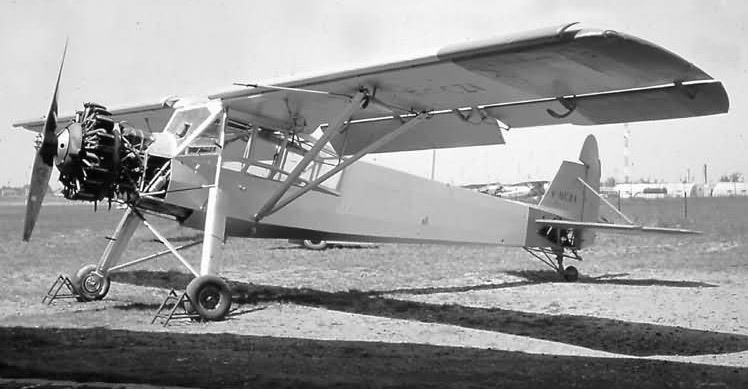
History During the War and Post-War
By the end of the decade, the winds of war made Morane-Saulnier grow again and in 1939 the new plant was built in Puteaux, but France’s participation was very short as by June 1940 it was largely occupied by the Germans. During the occupation, from 1941 the Puteaux plant was forced to manufacture the Fieseler Fi.156 Storch for the Luftwaffe, while a small group of technicians and employees managed to escape to the unoccupied part of France and in a plant of the former Breguet located in Tarbes-Ossun restarted the development of a couple of new models. This situation ended when in November 1942 France was fully occupied by the Germans. At the Puteaux plant, 141 Fieseler FI-156 were manufactured, while Tarbes-Ossun built the MS-403 fighter for the Germans until March 1944 when it was bombed by the allies and put out of service.
After France was liberated in 1944, Morane-Saulnier reconstructed the Puteaux and Tarbes plants with State aid and continued manufacturing the Fi.156, now under the new designation of MS-500 model. The first deliveries were for the Armée de l’Air and the Aéronautique Navale, and from 1946 for the Armée de Terre, using the German Argus 10C engines that had remained in the factory. And in 1946, the SGACC (Secrétariat Général à l’aviation Civile et Commerciale) commissioned the construction for civilian use of the MS-501 model with a Renault 6Q 233 hp inline engine and the MS-502 with the Salmson 9Ab 230 hp radial engine. The first was never built in series, while the second was baptized Criquet and was made in large quantities, as the initial order was for 1,075 aircraft (later reduced to 925). Formal production of the MS-502 ended in March 1947, but from 1963, due to the lack of spare parts for the Salmson engines, many re-engining operations were carried out with Jacobs R755 radials and even with some opposed-cylinder Lycoming engines, but these were not new aircraft.
The post-war commercial success of the Morane-Saulnier company was limited and in November 1962 it declared bankruptcy, just when its excellent MS-880 Rallye model was pointing toward success. In January 1963, the Henry Potez group acquired all the rights of the failed company and created based on it the Société d’Exploitation des Etablissements Morane-Saulnier (SEEMS), but in 1966 the Potez group of companies also became immersed in financial problems and was absorbed by Sud Aviation (later Aerospatiale). To continue with the construction of the now successful Rallye, the parent company Sud Aviation created the Société de Construction des Avions de Tourisme et d’Affaires (SOCATA), which is a completely separate story.
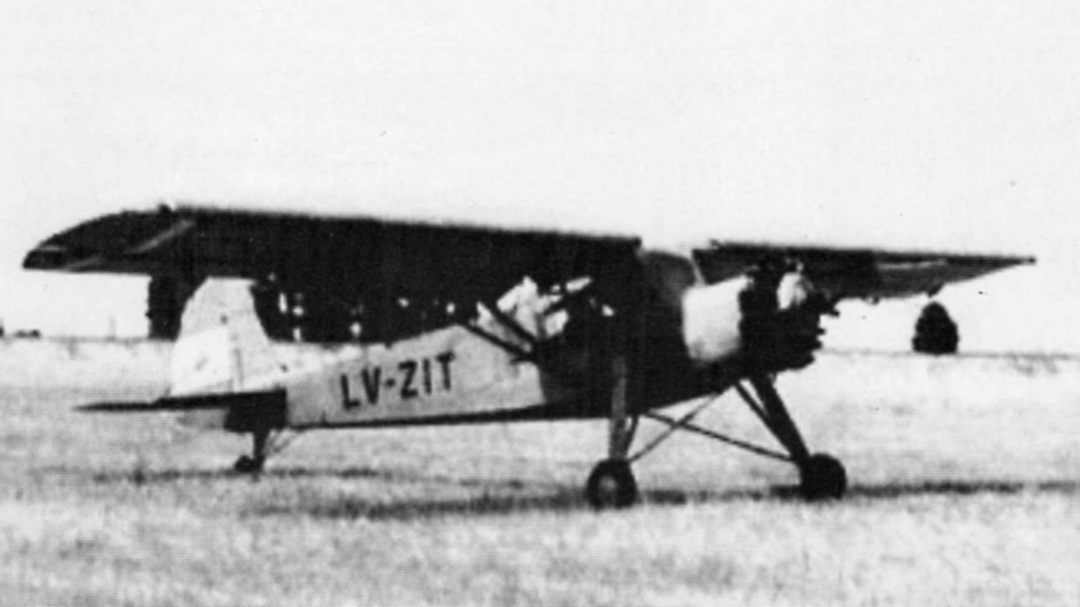
In Argentina…
After the war, France had restarted its aeronautical industry in an unorthodox way, as it was the State who paid for the manufacture of large series of military and civilian aircraft, several of them derived from German designs they had been forced to produce during the occupation. This maneuver, costly but effective, was the origin of a parallel commercial organization known as OFEMA (Office Français d’Exportation de Matériel Aéronautique), whose function was to sell French aeronautical industry products outside France. From late 1946, OFEMA’s representative in Argentina was the company Franimex S.A., with offices at 281 Reconquista Street in the Buenos Aires Federal Capital, and it was responsible for importing all French aircraft that arrived in the country at that time, including the first Nord 1203 Norecrin, the only Stampe SV.4C and Nord 1002, and even a curious SECAN Courlis.
Although Franimex’s name doesn’t appear in the available documentation, the time when the MS-502s would have been purchased coincides with that of the mentioned models. In a report from the Aerotechnical Institute of that same year, an aircraft of this model appears with serial number 512 delivered on January 7, 1947, to be repaired after an accident. None of this should draw attention, but things change if I add that seven aircraft were registered in our Registry in 1952 and three in 1955, that is, between five and eight years after their possible purchase, and without any evidence of prior activity.
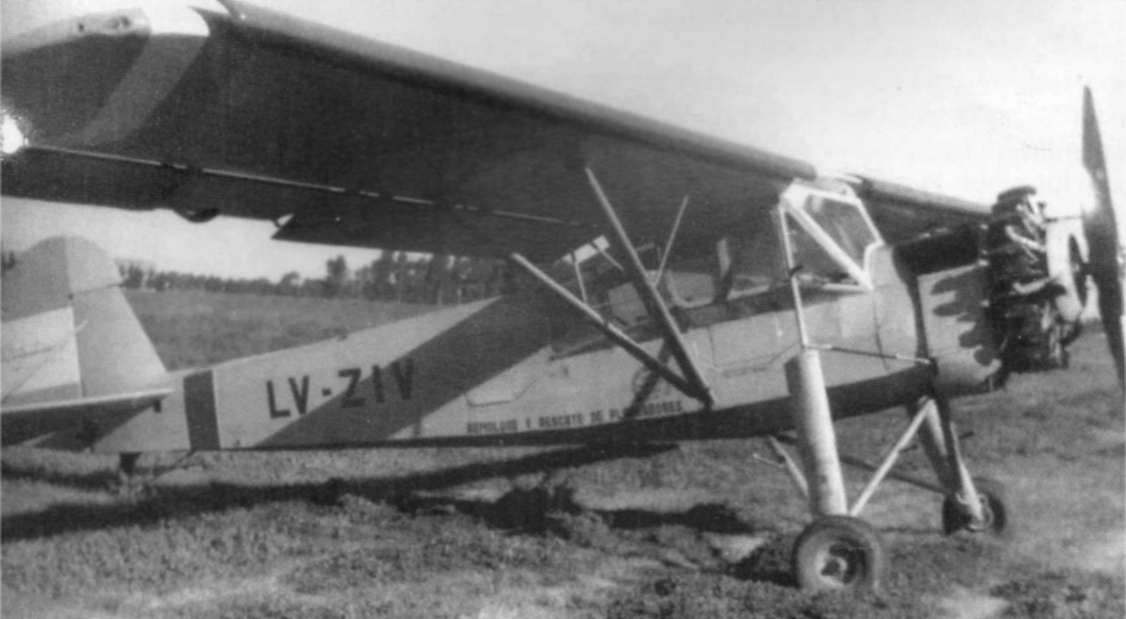
The French version of the Fieseler FI-156 that flew in Argentina was the MS-502, equipped with a nine-cylinder air-cooled Salmson 9Ab radial engine of 230 hp with a large diameter wooden propeller, two-bladed and fixed-pitch, which was originally of Chandiere brand. This engine gave the aircraft a somewhat untidy appearance, very different from the streamlined original design with the Argus engine.
Structurally it was a high-wing monoplane, with conventional fixed landing gear, and a nominal capacity of three seats. The wings, an extraordinary design, had V-shaped struts and were equipped with leading edge slats along the entire wingspan (similar to Handley Page slats), and with the so-called Rollflügler along the entire trailing edge, a kind of combined flap and slotted aileron. The assembly was built entirely in wood with fabric covering, and each wing half could fold along the fuselage for storage in reduced spaces.
The fuselage was of conventional construction in welded steel tubes and was also fabric-covered. It incorporated a very large fully glazed cabin, with side windows in a structure that protruded and facilitated downward vision, very useful for observation tasks and for landings on unprepared terrain.
The tail group was conventional, with wooden structure and covering and with fabric-covered control surfaces. It had a strut on each side between the fixed parts of the rudder and stabilizer.
The landing gear, another distinctive characteristic of this aircraft, consisted of two very tall main legs with very wide track and extremely long-travel hydropneumatic shock absorption, with low-pressure wheels equipped with hydraulic brakes. In the initial versions, a tail skid had been installed, but the aircraft used in our country had a tail wheel.
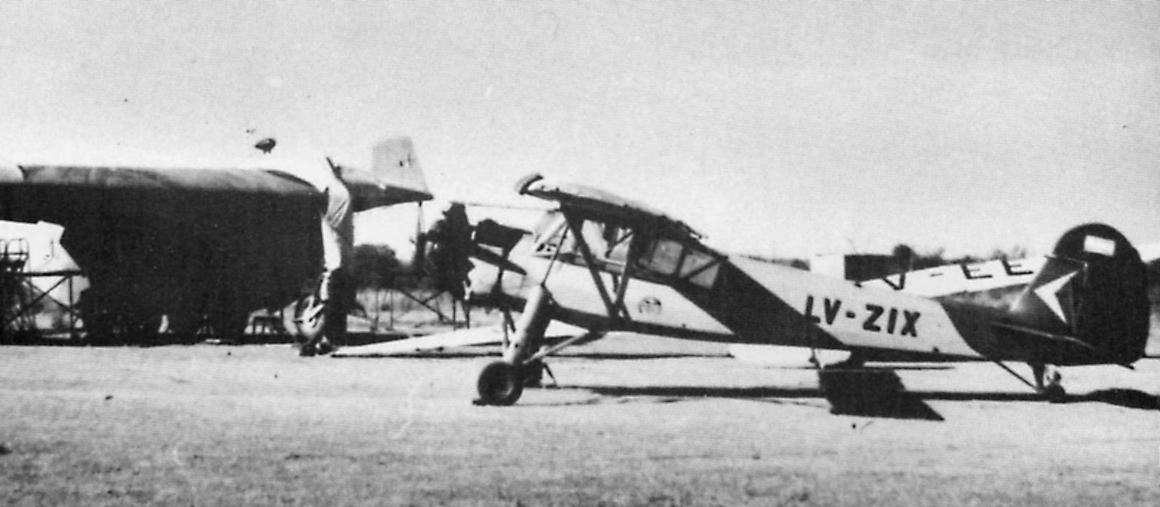
The MS-502s were assigned by the Ministry of Aeronautics (Civil Aviation Undersecretariat, DGAC) to various gliding clubs, but there is no record of these deliveries as the archives of these state organizations were incinerated some time ago, and since the aircraft owner did not change, the different users were not recorded in the National Aircraft Registry. The table accompanying this article contains the basic data of the ten aircraft that arrived in Argentina, so I will only add some complementary information about each of them below.
LV-ZIT, s/n 512 – This was the demonstrator imported by Franimex in 1946. Acquired by the State to be evaluated by the Air Force, it suffered an accident in late 1946, was repaired by the Aerotechnical Institute and remained in service until 1950, apparently with very little use. Once the remaining nine aircraft were imported, in early 1951 the Ministry of Aeronautics asked the Registry to reserve a group of registrations, assigning the correlative ones from LV-ZIT to LV-ZJF. As they came out of the San Fernando workshop, they were put into service with the already reserved registrations, but due to purely bureaucratic reasons, the formal registration of the first seven aircraft was only carried out on October 15, 1952, when they were already in service. Among them was this demonstrator, and with unusual consistency among bureaucrats, it was assigned the first registration, LV-ZIT. It was delivered to the Official Motorless Flight Base in Merlo, operated by the Albatros Argentine Gliding Club, where it towed gliders until it suffered an accident at the Siro Comi airfield in Monte Grande on August 14, 1955, with damages estimated at 25% that were never repaired.
LV-ZIU, s/n 680 – Registered in 1955, it was delivered on an unknown date to the Ministry of Aeronautics, which assigned it to the Junín Gliding Club, its only sporting user. The Club received it in ownership when it was donated thanks to Law No. 17314 dated June 19, 1967, and sold it to El Pinar S.R.L. in 1972. It had a long series of private owners and in February 1981 suffered an accident in Gándara, Buenos Aires province, which left it grounded until 1984 when it was completely rebuilt. Its last owner, Danilo José Monti, only had it for a short time as he sold it in Brazil to an intermediary named David Bauman on July 14, 1989. The aircraft was immediately resold in Switzerland, where it was destroyed in an accident in 1990.
LV-ZIV, s/n 681 – Registered in 1955, was assigned to the Official Motorless Flight Base in Merlo, where it was operated by the Quilmes Gliding Club. Currently preserved at the National Aeronautics Museum, at Morón, Buenos Aires.
LV-ZIW, s/n 682 – Registered in 1952, it was initially assigned to the Azul Gliding Club. After a short time, it passed to the Córdoba Gliding Club and was based at the Juárez Celman airfield, where it was destroyed in an accident that occurred in the nearby locality of Ascochinga on January 13, 1957.
LV-ZIX, s/n 686 – Registered in 1955. Assigned to the Official Motorless Flight Base, where it was operated by the Argentine Gliding Club Albatros. Some sources claim that it was exported to Brazil at an undocumented date.
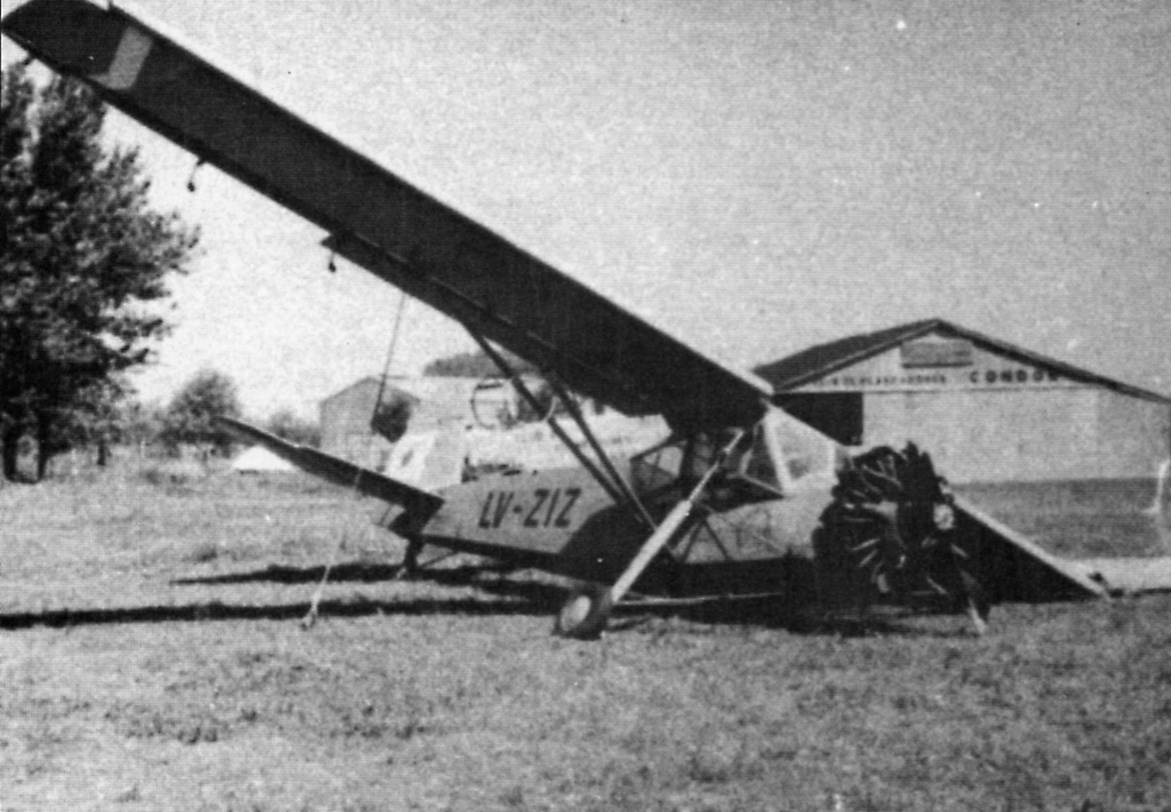
LV-ZIZ, s/n 689 – Registered in 1952. This aircraft was assigned as a tow plane to INAV (National Institute of Gliding) and was directed by Doctor Reimar Horten. It was based at the airfield of the Faculty of La Cruz, Córdoba province, and after the Liberating Revolution, it would have been reassigned to the Argentine Gliding Club Albatros of Merlo, Buenos Aires, where it suffered a serious accident on February 8, 1956. It was stored in deposit and was never repaired.
LV-ZJD, s/n 690 – Registered in 1952, it was initially assigned to the Esperanza Gliding Club, Santa Fe province, and later to the Los Caranchos Gliding Club, then based at the Military Aviation School of Córdoba. There it suffered a serious accident on July 13, 1962, and was never repaired.
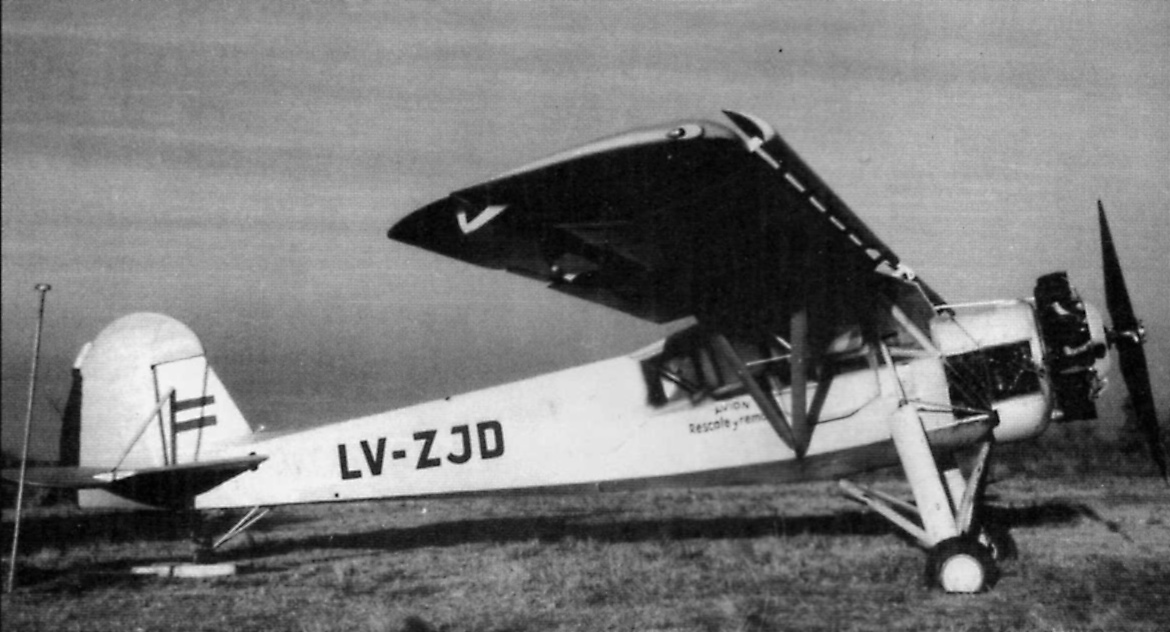
LV-ZJE, s/n 692 – Registered in 1952. The Ministry of Aeronautics assigned it to the Official Motorless Flight Base of Merlo. There it was used by the Argentine Gliding Club Albatros until September 1955 when General Perón’s government was deposed. It was then delivered to the Military Aviation School of Córdoba to continue in its role as a glider tow plane and would have been assigned the military registration F-1, which was never painted on it. Although not known with certainty, this was probably the MS-502 that towed the JA-41 Urubu glider piloted by Heinz Scheidhauer in his memorable crossing of the Andes Mountains on October 30, 1956, between the Bariloche airfield and the Chilean locality of Ensenada. It apparently was completely destroyed by fire in Córdoba on an unknown date.
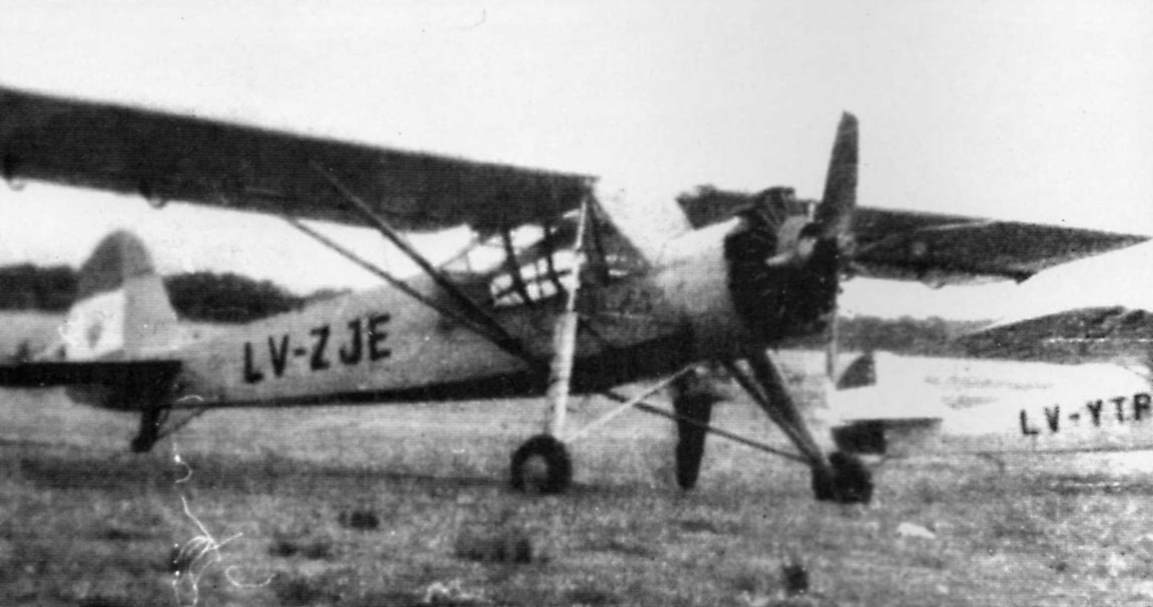
LV-ZJF, s/n 693 – Registered in 1952. Assigned to the Official Motorless Flight Base, it was used at the Merlo airfield until the Liberating Revolution of September 1955. Its subsequent life is unknown, although it is known that it flew in Córdoba (perhaps in the Air Force) until it crashed there in the locality of Guiñazú on September 27, 1956, with considerable damage. Although there is no evidence of its subsequent activity, it was not deregistered from the Registry until February 22, 1968.
LV-X???, s/n 001 – According to some comments heard in 2010, in the southwest area of Greater Buenos Aires, an MS-502 was being reconstructed based on a cabin and wings recovered from a crashed aircraft. The engine to be installed would be a rarity from an unidentified truck, a two-stroke V6. It is evident that it would be from one of the previous aircraft, but it will be very difficult to determine which one.
Morane-Saulnier MS-502 Specifications
The French version of the Fieseler FI-156 that flew in Argentina was the MS-502, equipped with a nine-cylinder air-cooled Salmson 9Ab radial engine of 230 hp with a large-diameter wooden, two-blade fixed-pitch propeller, which was originally built by Chauvière. This engine gave the aircraft a somewhat untidy appearance, very different from the stylized original design with the engine. Structurally, it was a high-wing monoplane with conventional fixed landing gear and a nominal capacity of three seats.
The wings, an extraordinary design, had V-shaped struts and were equipped with leading edge slats along the entire wingspan (similar to Handley-Page slats), and with the so-called Rollflügler along the entire trailing edge, a kind of combined flap and slotted aileron. The assembly was built entirely in wood with fabric covering, and each wing half could be folded along the fuselage for storage in reduced spaces.
The fuselage was of conventional construction in welded steel tubes and was also fabric-covered. It incorporated a very spacious, fully glazed cabin, with side windows in a protruding structure that facilitated downward visibility, very useful for observation tasks and for landings on unprepared terrain.
The tail group was conventional, with wooden structure and covering, and with fabric-covered moving surfaces. It had a strut on each side between the fixed parts of the rudder and stabilizer.
The landing gear, another distinctive characteristic of this aircraft, consisted of two tall main legs with very wide track and long-travel hydropneumatic shock absorption, with low-pressure wheels equipped with hydraulic brakes. In the initial versions, a tail skid had been installed, but the aircraft used in Argentina had a tail wheel.
Wingspan: 14.25 m
Length: 9.66 m
Height: 3.10 m
Wing area: 26.00 m2
Empty weight: 915 kg.
Maximum takeoff weight: 1370 kg.
Maximum speed: 170 km/h
Cruise speed: 136 km/h
Landing speed: 50 km/h
Service ceiling: 4300 m
Normal range: 700 km
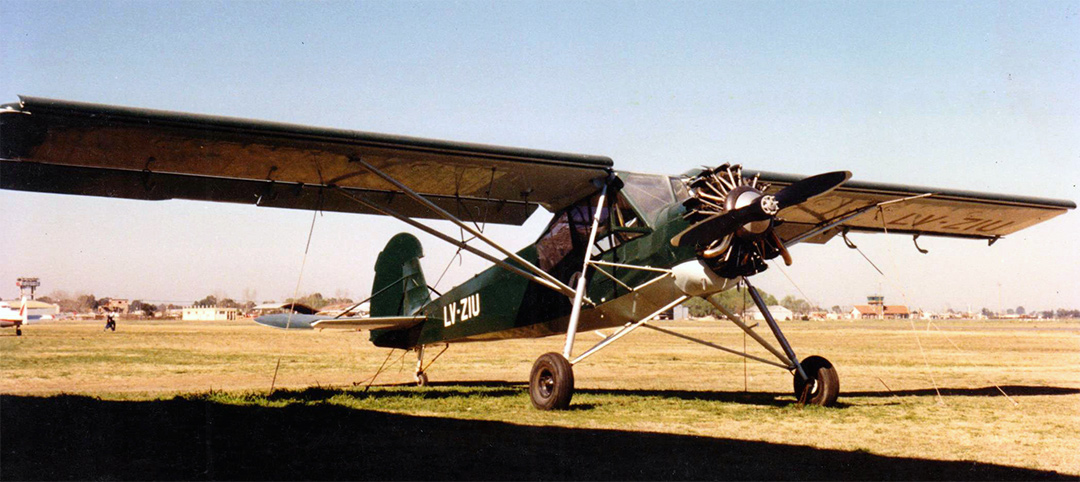
Morane-Saulnier MS-502 Registry in Argentina
| c/n | Year | Registration | Registered | 1st User | 2nd Assignment | Last User | Notes | Exists |
|---|---|---|---|---|---|---|---|---|
| 512 | 1946 | LV-ZIT | 15.10.52 | Ministry of Aeronautics | Official Motorless Flight Base | Albatros Gliding Club | Accident Monte Grande, 14.08.55 | No |
| 680 | 1947 | LV-ZIU | 28.06.55 | Ministry of Aeronautics | Junín Gliding Club | Danilo José Monti | Exported to Brazil and Switzerland | No |
| 681 | 1947 | LV-ZIV | 28.06.55 | Ministry of Aeronautics | Quilmes Gliding Club | Preserved at the National Aeronautics Museum, at Morón. | Yes | |
| 682 | 1947 | LV-ZIW | 15.10.52 | Ministry of Aeronautics | Azul Gliding Club | Córdoba Gliding Club | Accident Ascochinga 13.01.57 | Yes |
| 686 | 1947 | LV-ZIX | 28.06.55 | Ministry of Aeronautics | Official Motorless Flight Base | Albatros Arg. Gliding Club | Deregistered 06.11.68 | No |
| 688 | 1947 | LV-ZIY | 15.10.52 | Ministry of Aeronautics | Córdoba Gliding Club | Exported to Brazil | ?? | |
| 689 | 1947 | LV-ZIZ | 15.10.52 | Ministry of Aeronautics | INAV | Albatros Arg. Gliding Club | Accident Merlo, 08.02.56 | No |
| 690 | 1947 | LV-ZJD | 15.10.52 | Ministry of Aeronautics | Esperanza Gliding Club | Los Caranchos Gliding Club | Accident EAM Córdoba, 13.07.62 | No |
| 692 | 1947 | LV-ZJE | 15.10.52 | Ministry of Aeronautics | Official Motorless Flight Base | Argentine Air Force | EAM Córdoba, destroyed by fire | No |
| 693 | 1947 | LV-ZJF | 15.10.52 | Ministry of Aeronautics | Official Motorless Flight Base | Argentine Air Force | Accident Guiñazú, 27.09.56 | No |
Sources and Bibliography
- Revue de l’Aviation Icare. Morane-Saulnier 1918 – 1968. Paris, edition N° 217, June 2011.
- Airlife’s General Aviation. R. W. Simpson. Airlife, London, 1991.
- Jane’s All The World Aircraft. London, edition 1947.
- Interavia ABC. Edition 1965.
- Argentina National Aircraft Registry.
- Author’s Archives.
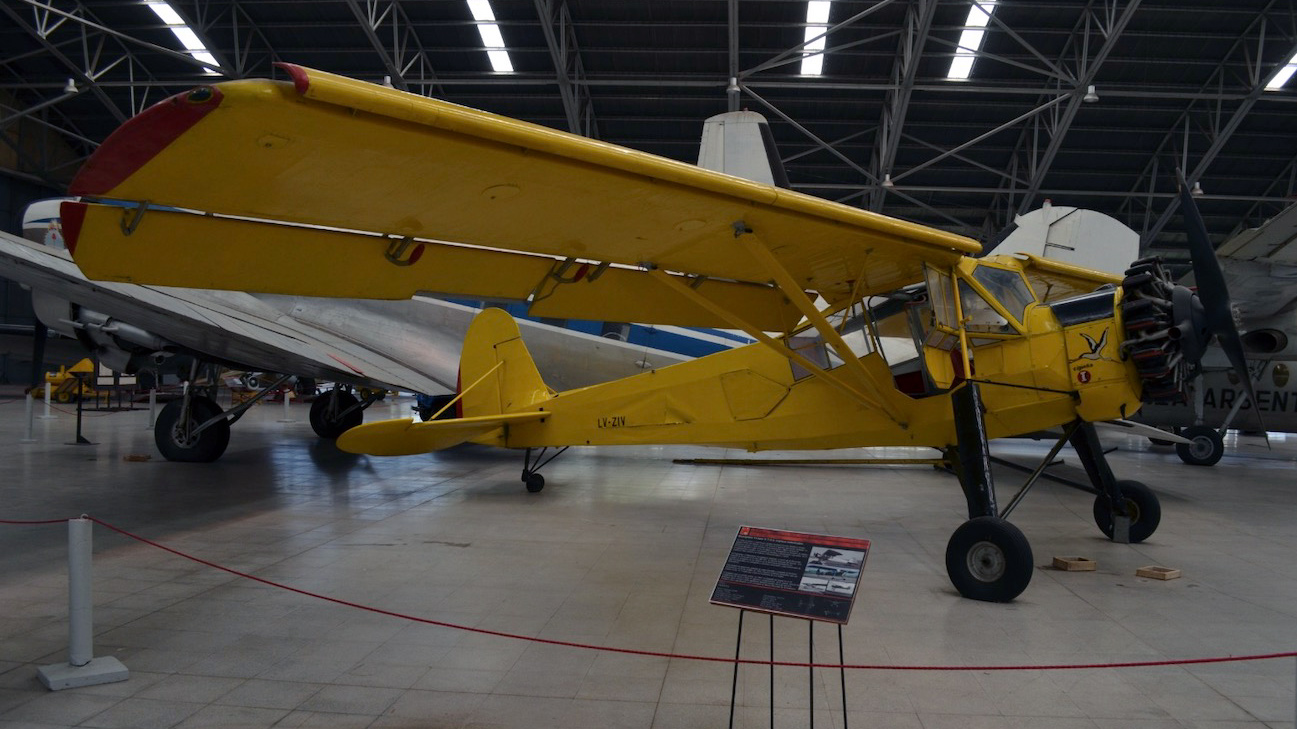
This article was originally published in LV Magazine, issue No. 47 (spring 2014).

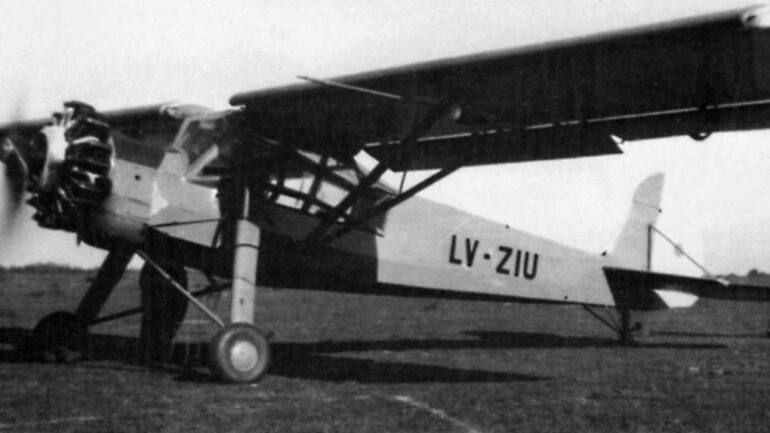
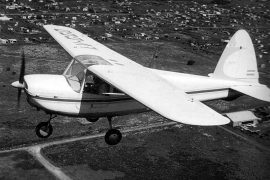

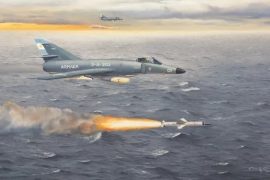
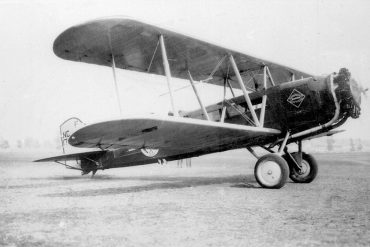
Truly outstanding and most welcome English-language contribution on these very misunderstood aircraft by a distinguished aero-historian. Well done, Sir!